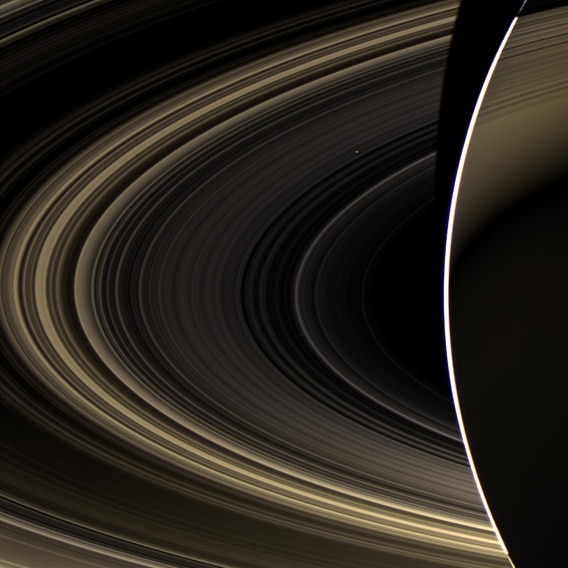Create a free profile to get unlimited access to exclusive videos, sweepstakes, and more!
Venus… from Saturn

A few years back, the folks who run the imaging from the Cassini spacecraft created a drop-dead stunning mosaic of the ringed world showing the Earth peeking out from the rings. This week they released another image, but this time it shows the planet Venus playing planetary hide-and-seek:
This picture is very cool, and I have to admit it really threw me for a moment. Cassini was behind Saturn when it took this; that is, the Sun is on the other side of the planet, so all Cassini saw of Saturn itself is a very thin illuminated arc.
Venus is the bright spot just off the edge of the planet to the upper right (the other dot of light closer to the bottom is a star). It may not look like much, but remember, Saturn is a long way from the Sun. When this shot was taken, on Jan. 4, 2013, the gulf of space separating the two planets was about 1.4 billion kilometers (850 million miles)! From Earth, Venus is the third brightest natural object in the sky. From Saturn? Not so much. So thatâs pretty cool.
So all by its lonesome, thatâs enough to make me marvel at this image. But it took me several seconds to understand what I was seeing in this image. Saturn and Venus were obvious enough, but whatâs the deal with those fuzzy arcs? Those must be part of a ring, but their angle off the planet didnât make sense to me. Shouldnât they look more perpendicular to the arc?
Then suddenly my perspective changed, and I saw my mistake. I thought both arcs were part of the same ring; the broader one the part of the ring that was nearby, and the thinner one above it the same ring arcing back around to go behind the planet. But thatâs wrong! Those are two different rings both on the near side of the planet. The broad one is Saturnâs E ring, a wide, diffuse collection of particles supplied, in part, by geysers erupting off of the tiny moon Enceladus.
The thinner one is the G ring, also somewhat diffuse but not nearly so much as the E ring. My eye and brain were trying to connect them into one ring, and that effect was magnified by the G ring looking thinner and therefore (according to my primitive brain) farther away. But the angle of the rings to the planet arc made couldnât possibly be right, my brain continued. And thatâs when it made a decision: see them a different way. When I realized they were two different ringsâthe G ring is closer in to Saturn than the E ringâit all made sense. Iâll note the blue color in the E ring is due to the ice particles in the ring scattering sunlight toward you. Blue light is more strongly affected that way than red, so it makes the ring look blue.
I love Cassini pictures from Saturn. Not just because theyâre so lovely, and show such a magnificent view of our Universeâthough there is that. But itâs also because they so commonly twist my brain up, giving me just enough information to figure out what Iâm seeing, but not making it so screamingly obvious. It sometimes takes a bit of thought to unravel what the pictures are saying, and what the eye is telling the brain.
Itâs a bit of mental gymnastics that always makes me smile. Science is fun.














